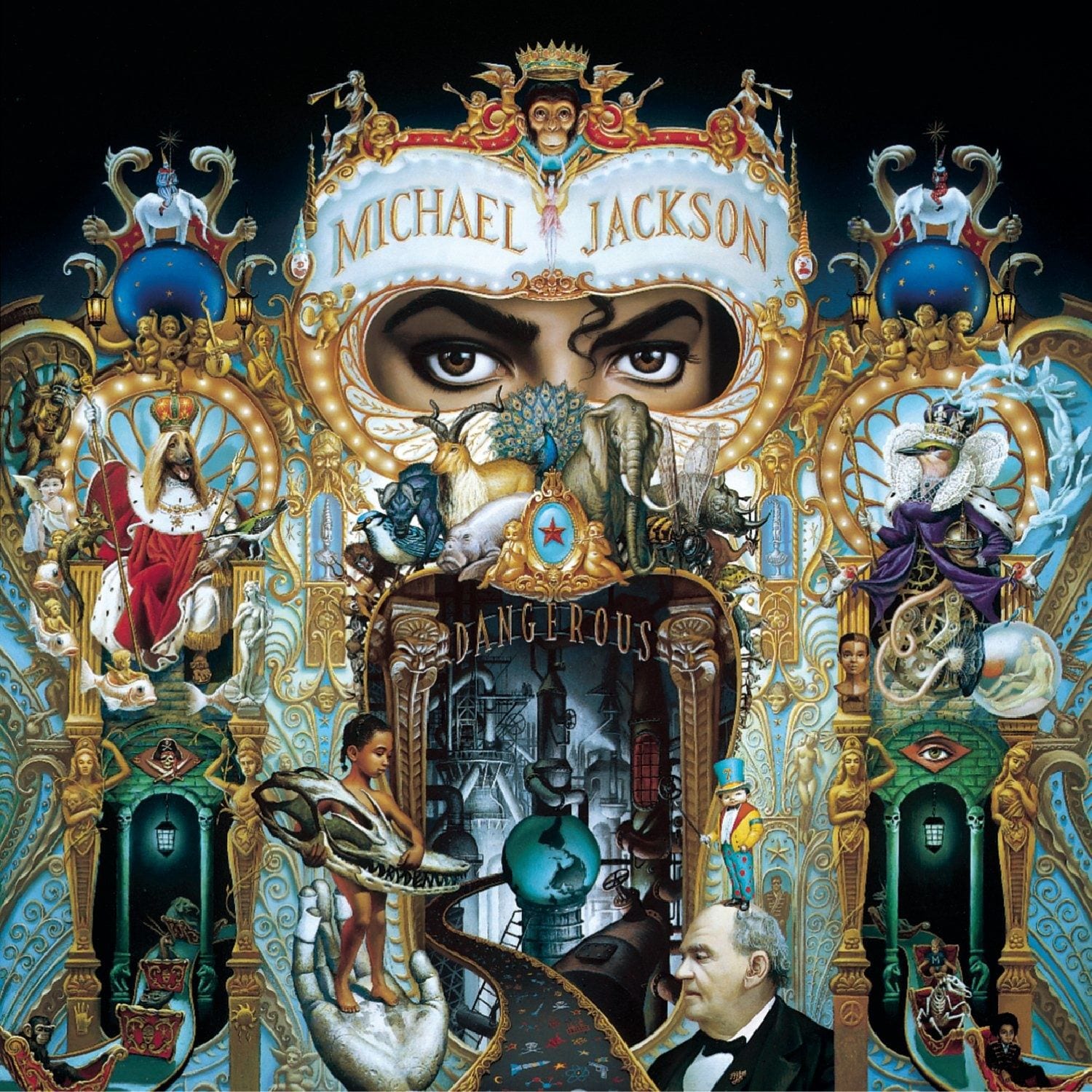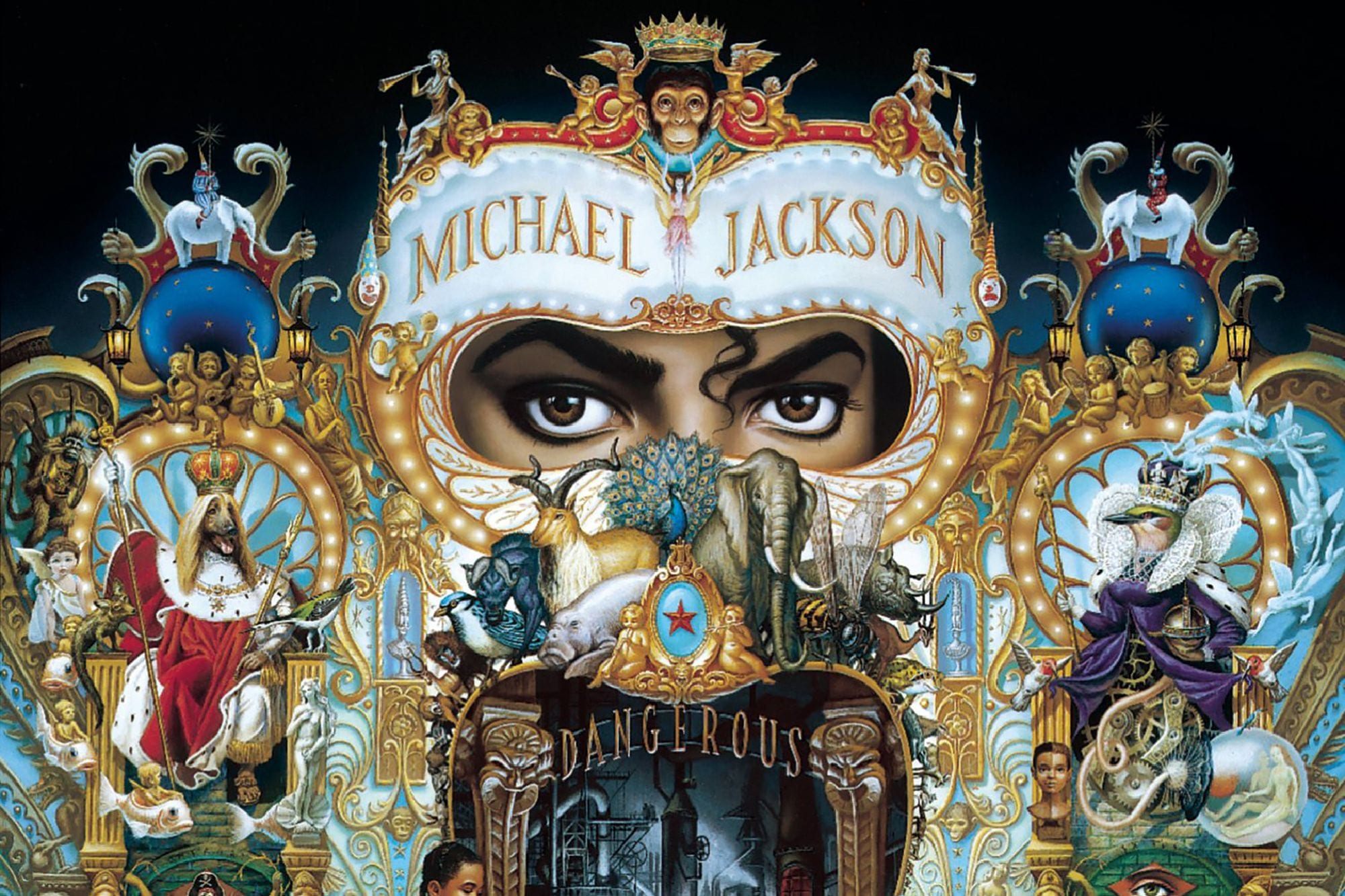
As the traditional narrative has it, Michael Jackson‘s Dangerous album represented the end of an era: the death of pop and the rise, in its wake, of grunge, alt-rock, and hip-hop. Most critics point to the moment Nirvana’s Nevermind knocked Dangerous out of the #1 spot on the Billboard Charts as the symbolic turning point. Within months, muted flannel had smothered all trace of ’80s excess and flamboyance.
Cultural transformations, of course, are never quite that simple. Several months after Nevermind reached the #1 spot, Nirvana shared the stage at MTV’s Video Music Awards with stadium rockers like Def Leppard, Van Halen, Metallica, and what remained the biggest band in America — Guns N’ Roses. Indeed, if one were forced to pin down a cultural turning point, the 1992 VMAs wouldn’t be a bad choice. Watching Nirvana’s subversive performance (which began with a few bars of the banned “Rape Me” before relenting into the moody “Lithium”) shortly after Def Leppard’s cartoonish “Let’s Get Rocked” not only made ’80s rock look ridiculous, but it soon made it nearly obsolete. Even the mighty Guns N’ Roses, who closed the show with a spectacular performance of “November Rain”, were openly mocked by Nirvana as “corporate rock” and “packaged rebellion”. If ever there was a public changing of the guard, this was the night.
Michael Jackson, meanwhile, the defining pop icon of the ’80s, created an album in Dangerous that had as much — or little — to do with pop as Nevermind did. The stylistic differences are obvious enough. Nevermind was rooted in punk rock and grunge, while Dangerous was primarily grounded in R&B/New Jack Swing. Yet both expressed a strikingly similar sense of alienation, with many songs functioning as a kind of confessional poetry. Compare Cobain’s lyrics from “Lithium” — “I’m so happy / Cause today I found my friends / They’re in my head” — to Jackson’s on “Who Is It” — “It doesn’t seem to matter / And it doesn’t seem right / ‘Cause the will has brought no fortune / Still I cry alone at night.” Both albums also contained their share of catchy pop hooks and choruses while introducing more underground sounds to mainstream audiences, and both albums were sung by wounded, sensitive souls who happened to be brilliant marketers/mythmakers.
Sonically, Dangerous shared little in common with the work of fellow pop stars like Madonna, Whitney Houston, and Mariah Carey. Its tone was much more ominous, gritty, urban, and industrial. In short films like “Black or White”, Jackson was likewise exploring darker territory, shocking middle-class audiences with his raw expression of pain and indignation at racism. Ironically, it was the “establishment pop star,” not the outsider grunge band, whose music video was censored following public outcry over its controversial coda. “Smells Like Teen Spirit”, meanwhile, was in such heavy rotation it had one MTV executive gushing that they had “a whole new generation to sell to.”
The point is that, contrary to conventional wisdom, by the end of 1991, Nirvana was as much “pop” as Michael Jackson — and Michael Jackson was as much “alternative” as Nirvana. Both artists’ albums were released by major labels and had similar commercial and chart successes, though they were measured against much different expectations. Each produced hit singles. Each elicited memorable videos and performances that played side-by-side on MTV. And each has now sold in excess of 30 million copies worldwide.
Nevermind, of course, has received far greater critical acclaim, both for its cultural import and artistic substance. Yet 20 years later, Dangerous is gaining admirers as more people move beyond the extraneous nonsense that was so prominent in contemporaneous reviews and pay attention to its content: its prescient themes, its vast inventory of sounds, its panoramic survey of musical styles.
The bottom line is this: If indeed it is considered a pop album, Dangerous redefined the parameters of pop. How else to explain an album that mixes R&B, funk, gospel, hip-hop, rock, industrial, and classical; an album that introduces one song (“Will You Be There”) with Beethoven’s Ninth Symphony and another (“Dangerous”) with what sounds like the heart of a steel-city factory; an album that can alternately be paranoid, cryptic, sensual, vulnerable, idealistic, bleak, transcendent, and fearful? Even the album cover — an acrylic painting by pop surrealist Mark Ryden featuring a circus-like mask through which Jackson gazes back at his audience — signifies a new depth and awareness.
Jackson sets the tone from the opening track. In place of the pristine, cinematic grooves of Bad is something more attuned to the real world, something more edgy and urgent. The shattering glass at the beginning of “Jam” fittingly symbolizes the breakthrough. Dangerous was Jackson’s first album without legendary producer Quincy Jones. Many thought he was crazy to part ways with Jones, given the pair’s unprecedented success together. Yet Jackson liked challenges and was invigorated by the idea of acting as executive producer and working with a fresh canvas. He began experimenting with a group of talented producers and engineers he had developed relationships with in the previous years, including Bill Bottrell, Matt Forger, and Bryan Loren; later in the process, he also brought back longtime engineer, Bruce Swedien. What resulted from the recording sessions — which spanned from 1989-1991 — was his most socially conscious and personally revealing album to date.
Perhaps the most significant addition to the new creative team, however, wasn’t made until the final year. Jackson remained dissatisfied with many of the rhythm tracks. He wanted them to hit harder, to feel edgier. With this in mind, he reached out to then-23-year-old New Jack Swing innovator, Teddy Riley. Since the release of Bad in 1987, R&B and hip-hop had evolved in a variety of directions, from the provocative rap of Public Enemy, to the sexual bluntness of LL Cool J, to the aggressive New Jack Swing of Bobby Brown and Guy. Jackson wanted to take elements from all of the latest innovations and sounds, and bend, contort, and meld them with his own creative vision. While Dangerous is often characterized as New Jack Swing — because of Riley’s presence, no doubt — Jackson’s appropriation of the style is clear. The beats are often more dynamic and crisp, the rhythms more syncopated, the sound more visceral and industrial. Found sounds are used as percussion everywhere: honking horns, sliding chains, swinging gates, breaking glass, crashing metal. Jackson also frequently implements beatboxing, scatting, and finger-snapping.
Take a song like “In the Closet” and compare it to other late ’80s/early ’90s New Jack Swing. The differences are striking. Listen to the way the elegant piano intro gives way to the erotic, gyrating beat. Listen to how the song builds tension and releases, builds tension and releases, before the climax explodes at the 4:30 mark. Listen to the agile vocal performance, from the hushed, confessional narration, to the tight falsetto harmonies, to the passionate sighs, gasps and exclamations. It is one of Jackson’s most sexually charged songs, yet it still manages a certain subtlety and intrigue — even the title is coyly playing with expectations about sexuality. Unlike most R&B and pop songwriters, Jackson’s “love songs” almost always contain a certain ambiguity, dramatic tension, and mystery. See, also, “Dangerous”, which contains the lyric: “Deep in the darkness of passion’s insanity / I felt taken by lust’s strange inhumanity.”
It is the second half of the Dangerous album, however, that really showcases Jackson’s artistic range. Following the declarative blockbuster, “Black or White”, Jackson unveils one of the most impressive songs in his entire catalog, the haunting masterpiece, “Who Is It”. For those who still believe the myth that Jackson’s work declined after the ’80s, this track alone should dispel the notion. Not only is it expertly crafted (rivaling “Billie Jean”), it is Jackson at his most emotionally raw: “I can’t take it ’cause I’m lonely!” “Give in to Me” continues the dark tone, as Jackson unleashes pent-up angst over Slash’s blistering guitar stabs. It is a song that would be right at home alongside the contrasting quiet/loud song dynamics on Nevermind or the rough, metallic textures of U2’s Achtung Baby.
What comes next? A prelude taken from Beethoven’s Ninth Symphony, naturally, followed by two songs — “Will You Be There” and “Keep the Faith” — rooted in black gospel. Jackson then closes the album with a tender expression on the transience of life (“Gone Too Soon”), inspired by AIDS victim, Ryan White, before returning full circle to the industrial New Jack Swing of the title track.
For some, this kind of eclectic, maximalist approach to an album was viewed scornfully. Dangerous was criticized for being too long, over-the-top, and unfocused. What in the world, skeptics asked, was a song like “Heal the World” doing on an album with “Jam” and “Dangerous”? Certainly, it fell in contrast to the sustained sound and theme of an album like Nevermind. Jackson, of course, could have easily gone this route by adding a few more songs to the seven rhythm tracks he created with Teddy Riley. Yet ultimately, it was an aesthetic choice. Jackson valued diversity and contrast, both sonically and thematically. He loved the idea of surprising an audience with an unusual song sequence, or an unanticipated shift in mood. If traditional R&B couldn’t express a certain emotion, he found a style that could (thus, the epic, Biblically-rooted pathos of “Will You Be There” turns to classical and gospel). Albums, he believed, were journeys — and as he would later explain in reference to his This Is It concert series, he wanted to take people places they’d never been before.
Yet regardless of stylistic preferences, one must at least acknowledge the sheer audacity and talent of an artist who was able to draw from such disparate sources and create in such a variety of genres. Could Axl Rose do New Jack Swing? Could Kurt Cobain do hip hop? Could Chuck D do gospel? Yet Michael Jackson worked as comfortably with Slash as he did the Andrae Crouch Singers Choir or Heavy D.
What, then, is the legacy of Dangerous twenty years later? It was an artistic turning point for Jackson, shifting his focus to more socially conscious material, ambitious concepts, and a broader palette of sounds and styles. It is also the culminating expression of the New Jack Swing sound, contributing to late ’80s/early ’90s R&B what albums like Nevermind and Ten did for rock. His R&B-rap fusions set the blueprint for years to come, while his industrial soundscapes and metallic beats were later popularized by artists as disparate as Nine Inch Nails and Lady Gaga. In terms of the overall music scene in 1991 — which truly was a remarkable year for music — it may not have been as culturally overpowering as Nevermind, but it does stand alongside it (and a handful of other records) as one of the early decade’s most impressive artistic achievements.
In the end, Nirvana and company may have killed off ’80s rock. But if pop was dead, its “king” had successfully created alternatives.
* * *
This article was originally published on 27 September 1991.
- How the New Jack Swing Movement Redefined an Era - PopMatters
- Prince and Michael Jackson: The Rivalry and the Revolution ...
- Does Michael Jackson's Work Contain the Stuff of Genius ...
- Michael Jackson: Invincible - PopMatters
- Michael Jackson Forever - PopMatters
- Michael Jackson: Xscape - PopMatters
- Long Live the King: Remembering Michael Jackson - PopMatters
- Mythologizing Michael Jackson - PopMatters
- Michael Jackson and the Death of Monoculture - PopMatters

